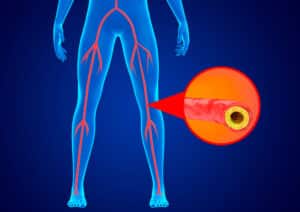
Those with PAD may experience cramping in the legs and hips during physical activity, known as intermittent claudication. They may also experience tingling, numbness, burning, or weakness in the lower extremities due to reduced blood circulation.
Learn more about the causes of PAD and what you can do to reduce the risk.
What Are the Causes of PAD?
The accumulation of plaques in the arteries is the root cause of peripheral arterial disease. Plaque is a collection of cellular debris, cholesterol, and fatty deposits. Those with high cholesterol, diabetes, high blood pressure, and obesity are the leading causes of plaque buildup in the body. Therefore, those with these conditions are at a higher risk of plaque buildup and developing arterial diseases such as PAD.
Some other possible risk factors may include a family history of PAD, heart disease or stroke, and smoking.
What Can You Do To Prevent Plaque Buildup?
There are a few things you can do to prevent plaque buildup and, therefore, reduce your risk of PAD. In general, the best thing you can do is to maintain a healthy lifestyle, which may include:
- Physical activity: Staying active is key to maintaining your weight, which can prevent obesity and high blood pressure, which are risk factors for PAD. Be sure to check with your physician about the best form of physical activity for you.
- Maintaining a balanced diet: Eating a well-balanced diet rich in fruits and vegetables, lean meats, and whole grains is essential for managing weight and avoiding health problems. It’s also important to minimize eating fatty, processed foods, which can lead to high cholesterol.
- Stop smoking: If you currently use tobacco products, it’s best to quit right away, as it can put you at risk of PAD, high cholesterol, and a number of other health concerns.
Learn More About PAD Treatments
At the Vascular Institute of Virginia, our expert team can provide you with excellent treatment options for PAD. To learn more, contact us at (703) 763-5524 or submit a contact form online. We proudly serve Fredericksburg, Woodbridge, Fairfax, VA, and the surrounding areas.

